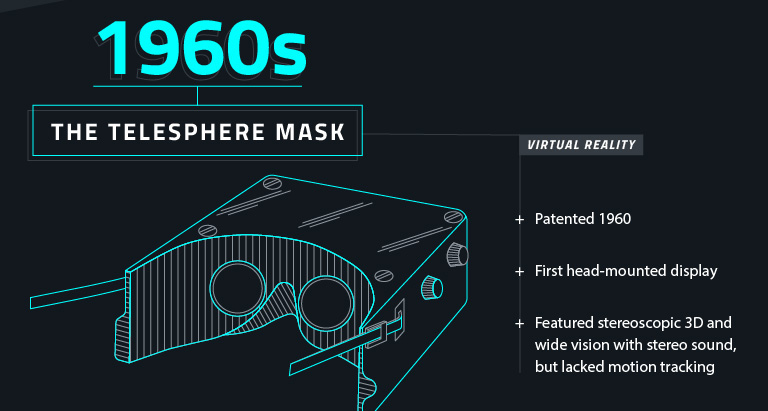Following the invention of the Gutenberg press, readers could use their imaginations to “get lost” in fiction books to take a break from all things ordinary. More recently, it has been inventions such as television, movies, and video games that have gotten us even closer to achieving true escapism. And while that progress is impressive, it is likely that today’s virtual reality technology may be the biggest leap forward yet. The virtual reality experiences coming out right now are so real and immersive, that the “realness” has actually become a potential psychological pitfall for developers to overcome. As the technology continues to grow, virtual reality will allow us the ultimate escape. We will be able to completely immerse in new experiences such as journeying to new planets, solving mysteries, or flying alongside our favorite superheroes to prevent the next global catastrophe.
The Evolution of Virtual Reality
Although it was the most recent developments in technology that have tipped virtual reality towards mainstream use, the concept of virtual reality itself has been a long time coming. Today’s infographic from Communications@Syracuse shows the evolution of virtual reality, and how new ideas and products over time have helped to put the technology on its current course.
Interestingly, the seeds for the evolution of virtual reality were actually sown as early as the 1930s and 1940s. The first important precursor was the Link Trainer, which was used as a flight simulator for the U.S. military. This device, which would be ultimately used to train over 500,000 U.S. pilots, was entirely electromechanical in nature. By using a series of pumps, valves, and bellows to respond to the pilot’s controls, it produced an accurate reading on flight instruments. Around the same time the Link Trainer became widespread in use, Sawyer’s View-Master was introduced at the New York World’s Fair in 1939-1940. Today it is still a popular children’s toy, having sold over 100 million viewers worldwide since then. The View-Master uses reels of stereoscopic film to provide the illusion of 3d images through the plastic binocular set.
on But fast forward to the end of last week, and SVB was shuttered by regulators after a panic-induced bank run. So, how exactly did this happen? We dig in below.
Road to a Bank Run
SVB and its customers generally thrived during the low interest rate era, but as rates rose, SVB found itself more exposed to risk than a typical bank. Even so, at the end of 2022, the bank’s balance sheet showed no cause for alarm.
As well, the bank was viewed positively in a number of places. Most Wall Street analyst ratings were overwhelmingly positive on the bank’s stock, and Forbes had just added the bank to its Financial All-Stars list. Outward signs of trouble emerged on Wednesday, March 8th, when SVB surprised investors with news that the bank needed to raise more than $2 billion to shore up its balance sheet. The reaction from prominent venture capitalists was not positive, with Coatue Management, Union Square Ventures, and Peter Thiel’s Founders Fund moving to limit exposure to the 40-year-old bank. The influence of these firms is believed to have added fuel to the fire, and a bank run ensued. Also influencing decision making was the fact that SVB had the highest percentage of uninsured domestic deposits of all big banks. These totaled nearly $152 billion, or about 97% of all deposits. By the end of the day, customers had tried to withdraw $42 billion in deposits.
What Triggered the SVB Collapse?
While the collapse of SVB took place over the course of 44 hours, its roots trace back to the early pandemic years. In 2021, U.S. venture capital-backed companies raised a record $330 billion—double the amount seen in 2020. At the time, interest rates were at rock-bottom levels to help buoy the economy. Matt Levine sums up the situation well: “When interest rates are low everywhere, a dollar in 20 years is about as good as a dollar today, so a startup whose business model is “we will lose money for a decade building artificial intelligence, and then rake in lots of money in the far future” sounds pretty good. When interest rates are higher, a dollar today is better than a dollar tomorrow, so investors want cash flows. When interest rates were low for a long time, and suddenly become high, all the money that was rushing to your customers is suddenly cut off.” Source: Pitchbook Why is this important? During this time, SVB received billions of dollars from these venture-backed clients. In one year alone, their deposits increased 100%. They took these funds and invested them in longer-term bonds. As a result, this created a dangerous trap as the company expected rates would remain low. During this time, SVB invested in bonds at the top of the market. As interest rates rose higher and bond prices declined, SVB started taking major losses on their long-term bond holdings.
Losses Fueling a Liquidity Crunch
When SVB reported its fourth quarter results in early 2023, Moody’s Investor Service, a credit rating agency took notice. In early March, it said that SVB was at high risk for a downgrade due to its significant unrealized losses. In response, SVB looked to sell $2 billion of its investments at a loss to help boost liquidity for its struggling balance sheet. Soon, more hedge funds and venture investors realized SVB could be on thin ice. Depositors withdrew funds in droves, spurring a liquidity squeeze and prompting California regulators and the FDIC to step in and shut down the bank.
What Happens Now?
While much of SVB’s activity was focused on the tech sector, the bank’s shocking collapse has rattled a financial sector that is already on edge.
The four biggest U.S. banks lost a combined $52 billion the day before the SVB collapse. On Friday, other banking stocks saw double-digit drops, including Signature Bank (-23%), First Republic (-15%), and Silvergate Capital (-11%).
Source: Morningstar Direct. *Represents March 9 data, trading halted on March 10.
When the dust settles, it’s hard to predict the ripple effects that will emerge from this dramatic event. For investors, the Secretary of the Treasury Janet Yellen announced confidence in the banking system remaining resilient, noting that regulators have the proper tools in response to the issue.
But others have seen trouble brewing as far back as 2020 (or earlier) when commercial banking assets were skyrocketing and banks were buying bonds when rates were low.

















